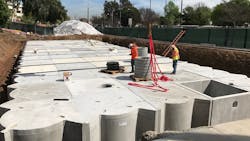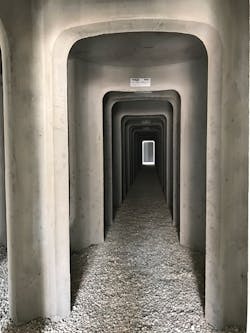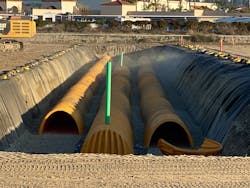The first installment in a two-part series. Read Part 2 in our upcoming January 2021 issue.
Whether it comes from falling rain, melting snow, or thawing ice, stormwater takes a few different routes once it reaches the ground. It either evaporates, soaks into the surrounding soil, or runs into a nearby river, stream, lake, or ocean. Once absorbed into the soil, the water is filtered and ultimately either replenishes aquifers or flows into streams and rivers.
As more undeveloped areas of the US are transformed into residential neighborhoods, commercial spaces, and roadways, there’s less and less soil to absorb the stormwater—and the development generates more runoff. A growing concern for municipalities nationwide, the collection, storage, transmission, and disbursement of this stormwater is a key consideration on all land development and redevelopment projects.
“In developed areas, impervious surfaces such as pavement and roofs prevent precipitation from naturally soaking into the ground,” points out EPA. Instead, that water runs rapidly into storm drains, sewer systems, and drainage ditches and leads to:
- downstream flooding;
- streambank erosion;
- increased turbidity (muddiness created by stirred up sediment) from erosion;
- habitat destruction;
- combined storm and sanitary sewer system overflows;
- infrastructure damage; and
- contaminated streams, rivers, and coastal water.
Stormwater runoff can also pick up and deposit harmful pollutants like trash, chemicals, and dirt/sediment into streams, lakes, and groundwater. EPA adds, “Construction sites, lawns, improperly stored hazardous wastes, and illegal dumping are all potential sources of stormwater pollutants.”
Keeping Water Where It Falls
Low impact development (LID) refers to systems and practices that use or mimic natural processes that result in the infiltration, evapotranspiration, or use of stormwater to protect water quality and the associated aquatic habitat. LID works with nature to manage stormwater as close to its source as possible, and uses strategies like “preserving and recreating natural landscape features and minimizing effective imperviousness to create functional and appealing site drainage that treat stormwater as a resource rather than a waste product,” EPA explains.
LID focuses on detention or “keeping water where it falls”; maintaining predevelopment discharge rates; capturing, reusing, or simply slowing the discharge; and avoiding downstream flooding. In terms of retention, LID focuses on infiltration into the ground (to replenish groundwater) and stormwater harvesting (the collection, accumulation, treatment or purification, and storing of stormwater for its eventual reuse).
MaryJane MacLeod, MPPA, Business Development Manager at Apex Companies LLC, in Los Angeles, says LID is a major improvement over earlier attempts to gather stormwater and keep it away from people. “We were collecting in huge conveyances like the Los Angeles River,” recalls MacLeod. “That was more of a flood control discharge approach.”
Today, more engineers and developers view stormwater as a resource and focus on collecting it onsite, treating it, storing it, and/or getting it back into the groundwater. This LID approach has gained popularity over the last 15–20 years and along the way has pushed developers to pay more attention to preserving the natural areas of their sites. “It’s about organizing your development in a way that minimizes its impact on hydrology,” says MacLeod, “and ensuring that any discharge doesn’t impact downstream bodies of water.” To achieve those goals, larger sites typically require some type of stormwater detention device whereby the water can be retained and then released slowly (aka, “metered”) over time.
Making the Right Choice
Because retaining or storing water is such an important element of LID, selecting the right stormwater storage system isn’t a decision to be taken lightly. Unfortunately, many of these systems are specified and installed with the particular goal of meeting stormwater permitting requirements at the lowest possible initial cost—and mainly with private developments—and then never looked at again. Over time, the systems fail, erode, or decay, losing effectiveness and creating high ongoing maintenance bills and even steeper replacement costs.
For privately owned systems, these problems are exacerbated when the properties change hands and the original owners are no longer responsible for the projects they created. If they picked unsuitable systems at the outlet, neglected to maintain them, and/or stopped monitoring them, the new owner’s repair or replacement bill could be steep. Along the way, the systems stopped operating as intended, and the potential hazards outlined earlier in this article will begin to surface.
Rock vs. Plastic vs. Concrete
When it comes to stormwater storage devices, engineers have several options to choose from. All of them fall into either the “open” or “covered” category. Open options include dry ponds and wet ponds. These ponds were popularized in the 1980s and built with the purpose of capturing, controlling, and filtering stormwater runoff. Dry ponds hold water for a short period of time before allowing it to discharge into a nearby body of water while wet ponds maintain a permanent pool of water year-round.
Both types of ponds present ongoing maintenance problems for their private owners or municipal governments. These present many challenges, not the least of which is the need for open space to build the pond itself. Other issues that have to be managed over time include abnormally high (or low) pool levels, clogging, accumulation of sediment (which, in turn, reduces overall storage volume), debris, pipe/riser damage, invasive plants, the loss of slope-stabilizing vegetation, and mosquito/vector control.
Covered stormwater systems offer a more controlled environment for the stormwater runoff, but not all systems are alike. In fact, even solutions constructed from the same materials may differ from one structure to the next. The basic covered options include rock-enveloped plastic chambers, plastic domes, plastic pipe, CMP, or precast concrete modules.
MacLeod says many designers stick to using the most economical system that meets the minimum requirements of the specifying agency without understanding the risks. The plastic and metal structures rely heavily on the rock envelope for their system strength. And while rock is capable of providing the required strength, these systems are completely dependent on the quality of installation by the contractor.
Engineers may have overlooked some or all of these points when burying a stormwater system underground at the Tanger Outlets in Lancaster County, PA. In 2018, shoppers and the mall owner experienced a real fright when a parking lot caved in. A sinkhole was initially blamed for the failure, but a lengthy investigation pinpointed the stormwater storage system as the real culprit. More than likely, there was either too much, not enough, or the wrong type of fill installed over the stormwater system. As a result, the weight of the parking lot and major rainfall had strained that plastic crate stormwater storage system, causing the collapse.
Along with the structural concerns of relying on rock to support the plastic and metal systems, water is typically stored in the rock and counts toward the total storage volume. The volume stored in the rock could account for over 50% of the total storage placing stored water outside the structure, below, beside, and even above the storage chamber/pipe. Because the rock storage is just 40% efficient, the footprints of these systems are generally larger and require more excavation and hauling of materials.
Finally, in light of the current proliferation of brush fires in California, Oregon, and Washington, the flammability of plastic systems should be factored into the selection process. When the Tanger Outlet Mall plastic chamber was replaced after its initial collapse, for example, the new system caught fire during the last stage of construction. Within minutes the system was fully engulfed, causing a second complete collapse and leaving a smoldering cavern of toxic waste.
Penny Wise and Pound Foolish
Plastic domes/chamber and metal pipe are tempting alternatives to concrete because they’re lighter, require less lead time, and at least on the surface appear to be less expensive. However, they do come with risks. Here are three key points to keep in mind:
They’re limited structurally. Plastic domes/chamber and metal pipe systems require great care during the installation. They generally require a greater minimum cover and are limited to the amount of fill material that can be used. They can’t always support traffic loads and each section relies on its rock backfill and the adjacent section for structural support. Because of this, replacing a single module may be impossible if one section becomes damaged.
Maintenance is difficult and costs are high. Many of these systems are also very costly to maintain. If neglected, they offer no physical access to restore the system to functionality. Once sediment enters the rock storage areas (and it will), it cannot be removed.
The total cost of ownership can be exorbitant. Factor in the added rock backfill, larger excavation, and additional material hauling, and the total cost of these systems are comparable to that of a concrete system. However, accounting for the additional liability risk, lifecycle cost, and maintenance, and the choice is clearly in favor of concrete.
Thinking Beyond Compliance
With four stormwater capture projects either underway or already finished, Richard Watson, president at Richard Watson & Associates, Inc., in Mission Viejo, CA, says his county’s Safe Clean Water Program made stormwater capture necessary for compliance’s sake and to enhance the public water supply. Using a parcel tax that generates roughly $300 million annually, the county has about $20 billion in total stormwater projects planned over the next two decades.
Pointing to Los Angeles Unified School District’s failed plastic stormwater system as proof that the material isn’t a good match for such systems, Watson says he prefers concrete for its durability and longevity. “When maintained properly,” he says, “the newer concrete systems will last 100 years.” He tells engineers who are designing these projects to factor in the strength of the units, ease of installation, and unit weight into the equation. “You want something you can bring in and install fairly quickly,” Watson adds.
Right now, Watson says he’s putting more thought into the circulation needed to keep the water fresh and ready for infiltration, versus just having it sit stagnant. This is of particular concern in areas where water is being stored for irrigation purposes. “How and where you’re going to treat that water are both important points,” says Watson, “as is the vector control you’re going to use to ensure that mosquitoes aren’t a problem.”
Putting Their Money Where Their Mouth Is
Regardless of the material, design, or style of the stormwater storage unit selected, there are certain constants that all engineers should consider when making this important choice. For starters, think beyond initial permitting and compliance requirements and consider both short- and long-term costs, maintainability, and durability. Factor in the risks (i.e., will an underground plastic or pipe design hold up to the weight that will be on top of it?), the ease of installation, and the long-term functionality of the product.
“Make sure the product has been tested against the engineering protocols like ASTM and/or engineering requirements. For me, that’s paramount,” MacLeod advises. For example, can that manufacturer say, “Yes, we have tested this not only in a lab but in an actual use.”
Finally, if something does go wrong or if the product fails, how much will the repair or replacement cost and who will handle it? These are all important considerations that aren’t always included in the early conversations about stormwater storage products. “Do your own research, talk to a lot of different manufacturers, and ask for data,” MacLeod adds. “And make sure that whomever you’re speaking with can put their money (or their testing) where their mouth is.”
Mark Cuneo is a former city engineer for the cities of Santa Monica and Beverly Hills and is currently a proj- ect manager for a civil infrastructure contractor.
References
US Environmental Protection Agency. Greening EPA: Water Management. “EPA Facility Stormwater Management.” www.bit.ly/2Udd2Nb
US Environmental Protection Agency. Source Water Protection. “Urbanization and Storm Water Runoff.” www.bit.ly/3eJxy1k
US Environmental Protection Agency. Polluted Runoff: Nonpoint Source (NPS) Pollution. “Urban Runoff: Low Impact Development.” www.epa.gov/nps/urban-runoff-low-impact-development
About the Author
Mark Cuneo
Mark Cuneo is a former city engineer for the cities of Santa Monica and Beverly Hills and is currently a project manager for a civil infrastructure contractor.



